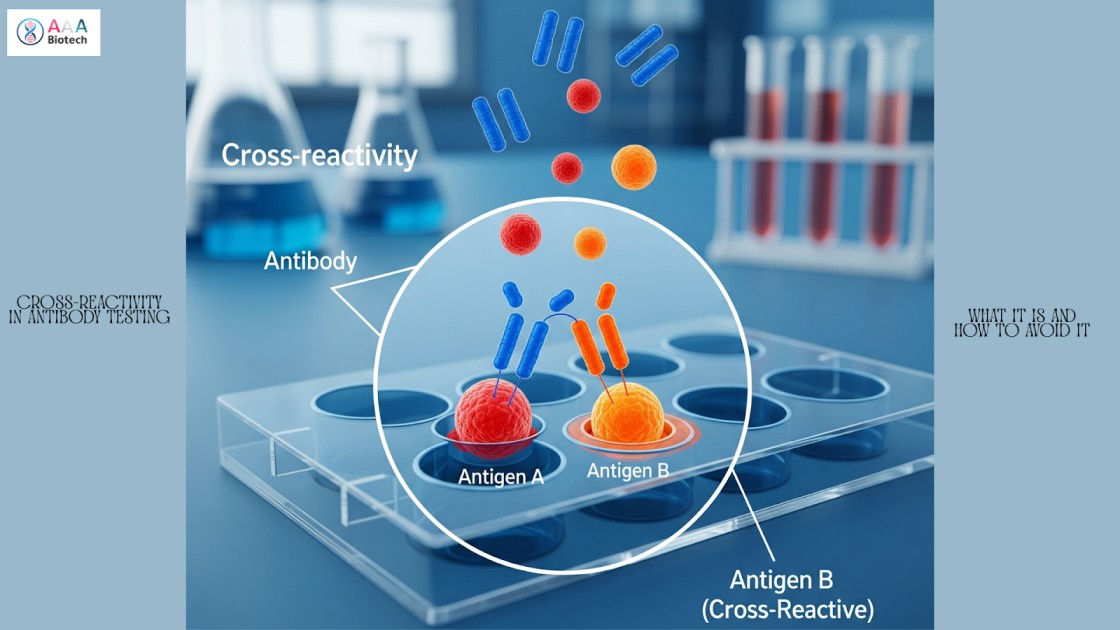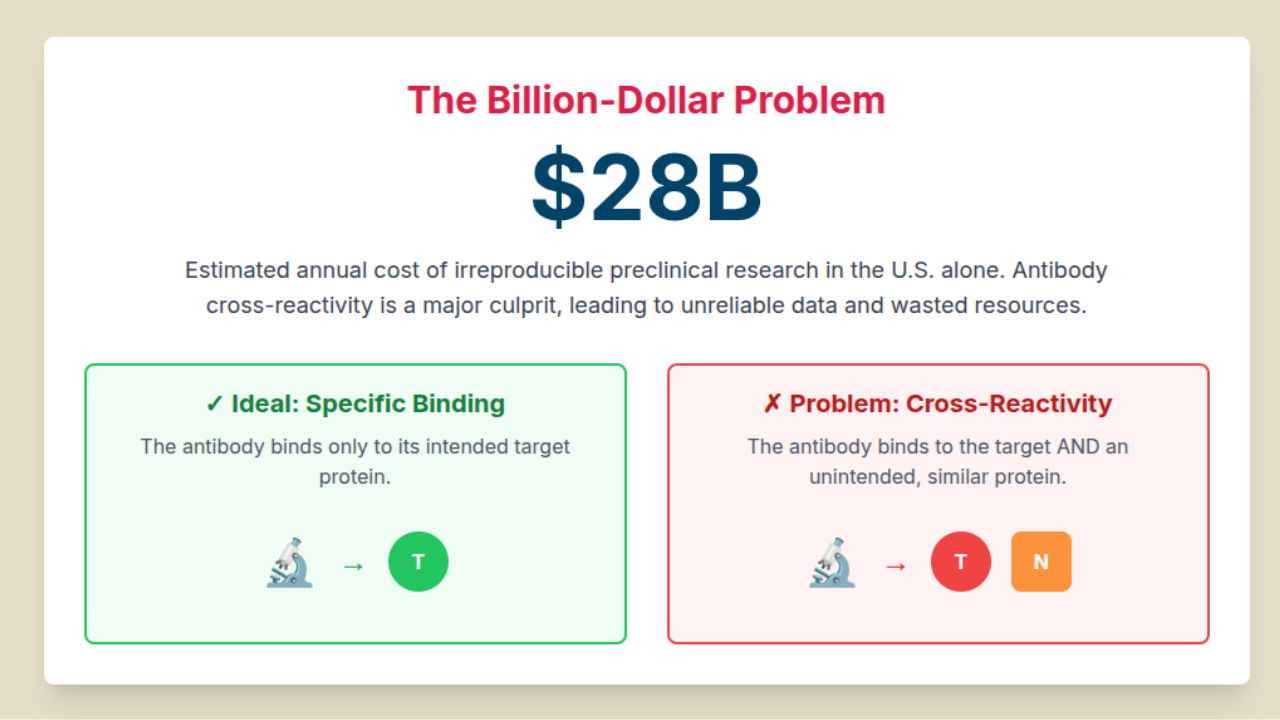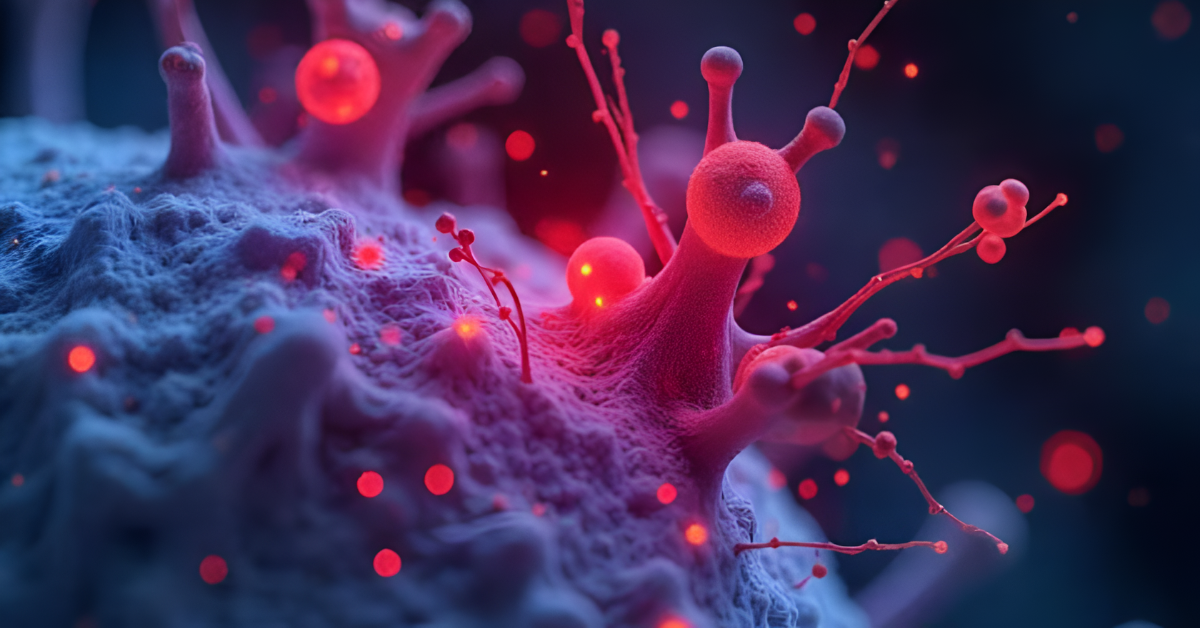Mitigating Cross-Reactivity In Antibody Testing: Precise Strategies For Reliable Results
In this Article
All of the products listed in AAA Biotech’s catalog are strictly for research-use only (RUO).

Key Takeaways
- Cross-reactivity in antibody testing is caused by unintended binding to chemically or structurally similar antigens, undermining assay and diagnostic accuracy.
- Even small differences in 3D structure or amino acid sequences (60–75% homology) can trigger extensive cross-reactivity in immunoassays.
- Polyclonal antibodies (pAbs) are more prone to cross-reactivity than monoclonal antibodies (mAbs) due to their recognition of multiple epitopes.
- Key methods to determine cross-reactivity include immunoblotting, immunoprecipitation, competitive ELISA, BLAST sequence analysis, and antibody arrays.
- High sequence similarity within protein families and isoform structures, as seen in MAPK family proteins, often causes undesired cross-reaction for relevant antibodies.
- Post-translational modifications (PTMs), like phosphorylation, can alter epitope structures and lead to non-specific antibody binding.
- Reducing cross-reactivity starts with selecting well-validated monoclonal antibodies, optimizing protocol conditions, and using cross-adsorbed secondaries.
- Reliable results demand computational screening (BLASTp), robust validation, and ongoing experiment optimization to ensure scientific reproducibility.
Laboratory tests involving antibodies form the foundation of many immunoassays.
Techniques such as ELISA, western blot, immunohistochemistry, and flow cytometry
rely heavily on antibodies because they act as molecular heat-seeking missiles,
ideally binding only to their intended target protein. But what happens when
these tools go off track?
This is the biological phenomenon of cross-reactivity that complicates antibody testing. It is the binding of an antibody to its intended target in addition to antigens other than its intended target. This may be due to similar structural motifs, such as comparable epitopes which can lead to false positives, unreliable assays, and result in poor clinical outcomes.
This mistaken identification can compromise clinical diagnostics, commercial products, and overall experimental integrity. Researchers have to understand the mechanisms that factor into relevant cross-reactivity as well as precise strategies to avoid it for robust assay results and scientific reproducibility.
Let us dissect the complexities of antibody cross-reactivity in order to understand this phenomenon in depth.
What Is Cross-Reactivity In Antibody Testing?
Cross-reactivity, at its core, is the binding of an antibody (developed for a
specific antigen) to other antigen(s) of containing similar structures/features
(3D or similar amino acid sequence). An antibody’s paratope may accommodate
multiple epitopes, which can produce non-specific signals.
This may be due to:
- Structural Similarity: If antigens show around 60-75% of
sequence homology, it can often lead to significant cross-reactivity
issues.
- Antibody Types: mAbs show higher specificity, while pAbs
are more prone to cross-reactivity because of their ability to recognize
multiple epitopes.
How To Determine Cross-Reactivity?
Various protocols are designed for specific lab experiments to diagnose
cross-reactivity and aid in validating antibody specificity.
| S.No | Method | Description | Insights |
|---|---|---|---|
| 01. | Immunoblotting | Visualizes antibody binding on separated proteins via Western blot | Verified Target vs no-target |
| 02. | Immunoprecipitation | Precipitates antibody-antigen complexes for specific analysis | Detects unintended targets |
| 03. | Competitive ELISA | Introduces reference antigens to identify non-specific binding | Quantifies cross-reactivity |
| 04. | Pairwise Alignment | Uses NCBI-BLAST to predict cross-reactivity via homology | <60%: Low risk; >75%: High risk |
| 05. | Antibody Array | Tests antibodies against multiple antigens using a microarray | Detects broad non-specific binding |
The capital loss due to antigen cross-reactivity cannot be overstated:
Factors Responsible For Cross-Reactivity
Cross-reactivity in immunology is responsible for unreliable assay results.
Multiple factors are contributors:
01. High Sequence Homology And Protein Families
The most frequent cause of cross-reactivity is “Epitope Sequence Similarity.” Proteins of the same family often have a large portion of a shared/similar amino acid sequence, which is also referred to as “sequence homology”, that can lead to binding to a related protein other than the intended target.
Example: Proteins of the MAPK family (p38, JNK, and ERK) may accidentally bind to a different protein in the same family that has a highly similar region to JNK.
02. 3D Structural Motifs
Isoforms are different versions of the same protein produced by the same upstream gene. Through the process of “Alternative Splicing”, these isoforms are made and differ sometimes by only a very small segment of the amino acid sequence.
This can lead to a similar 3D structures and can cause binding to an unintended target even if the sequences technically diverge.
03. Antigen-Antibody Affinity And Post-Translational Modifications (PTMs)
A strong antibody affinity can be responsible for overriding specificity, especially at low antigen concentrations. This can also be affected due to assay conditions like pH, temperature, and the composition of the buffer used.
The structure of an epitope can be altered by PTMs such as phosphorylation, glycosylation, and ubiquitination.
Example: A “phospho-specific antibody” might cross-react with other phosphorylated proteins that share a similar sequence surrounding the phosphorylated residue.
In Summary:
Impact Of Cross-Reactivity In Modern Research
Cross-reactivity has affected a wide spectrum of modern experiments. If it
remains unaddressed, it has the potential to cause extreme fluctuations in
workflows, such as:
- False positives in immunohistochemistry or ELISA antibody tests
- Misleading quantification of biomarkers
- Reduced assay reproducibility and validity
- Compromised clinical decisions in diagnostics
The Proactive Approach To Prevent Cross-Reactivity
Accuracy and precision in experiments involving antibodies can be achieved by predicting potential cross-reactivity issues. This can be done using the Basic Local Alignment Search Tool (BLAST), specifically “protein BLAST” (BLASTp).
Here is the breakdown of the workflow:
- Getting The Antibody’s Immunogen Sequence: Know the
specific amino acid sequence that was used to generate the antibody. A
trustworthy supplier of validated antibodies, such as AAA Biotech, will typically
provide this information on the datasheet (unless proprietary).
- Running BLASTp: Running “Protein BLAST” by pasting the
immunogen sequence into the NCBI BLAST website
tool.
- Selecting Organism: Specificying the organism (e.g., Homo
sapiens, Mus musculus) that a researcher is studying the model of is
crucial.
- Analyzing Results: The result obtained after running the sequence in BLAST will show a list of proteins from the target organism that have sequence similarity to the immunogen.
NOTE: The targeted protein should be at the top with 100% identity. If the sequence identity with other proteins is 85% or higher, then that protein is highly prone to cross-reactivity.
How To Avoid Cross-Reactivity For Reliable Results?
Preventing cross-reactivity in tests involving antigen-antibody interaction can
be achieved by controlling of the following factors:
- Selection and Validation: Selecting antibodies against the
targeted antigen, ideally with minimal sequence homology to off-target
proteins/analytes. For validation, using ELISA and immunoblotting is a must for
confirming specific binding and lack of off-target recognition.
- mAbs over pAbs: Monoclonal
antibodies have lower probabilities of cross-reactivity than
polyclonal antibodies because of mAbs target a single epitope.
- Optimization: Adjusting critical assay conditions such as
pH, temperature, and blocking agents to enhance specificity.
- Multiplexing: Be cautious while performing multiplex
assays. Using secondary antibodies that are subject to cross-adsorption to
minimize species cross-reactivity is highly encouraged.
| S.No | Strategy | Advantages | Risk Mitigated |
|---|---|---|---|
| 01. | Monoclonal antibody use | Single epitope specificity | Reduces off-target binding |
| 02. | Sequence analysis (BLAST) | Predicts cross-reactivity risk | Informs antibody selection |
| 03. | Competitive assays | Quantifies non-specific binding | Detects problematic clones |
| 04. | Blocking enhancement | Reduces non-specific background noise | Improves assay clarity |
| 05. | Multiple antibodies/epitopes | Targets multiple regions, confirms specificity | Avoids single-point error |
Final Results: Specificity Is The Foundation Of Good Science
Cross-reactivity remains a critical challenge in antibody testing and absolutely
has an impact on an experiment’s accuracy.
Minimizing the potential for unreliable results requires combining computational homology screening, robust assay design, and careful antibody selection. Knowing these strategies provides a bright outlook for future reduction of cross-reactivity and upgrading antibody testing standards.
Be diligent, be skeptical, and let specificity be your guide, as these principles will always lead to the foundation of good science.
Faq's
Is cross-reactivity always harmful?
Not always. Cross-reactivity can be useful in the case of studying a protein in a species for which a highly-characterized specific antibody hasn’t been developed yet.
Are polyclonal or monoclonal antibodies more prone to cross-reactivity?
pAbs are more prone to cross-reactivity as opposed to mAbs because of their nature to
recognize multiple epitopes.
Which method is ideal to confirm antibody cross-reactivity?
Some standard laboratory methods include competitive ELISA, immunoblotting, and immunoprecipitation to analyze and quantify cross-reactivity.
How can I improve my signal-to-noise ratio to reduce background that might be conflated with cross-reactivity?
Protocol optimization is crucial for blocking buffer (5% BSA or milk) and titrating primary and secondary antibodies for optimal concentration that will improve the signal-to-noise ratio for reliable experimental results.
How do blocking agents help in reducing cross-reactivity during ELISA or immunostaining?
Blocking buffers like bovine serum albumin (BSA) decrease non-specific binding, minimizing background and improving assay specificity.








